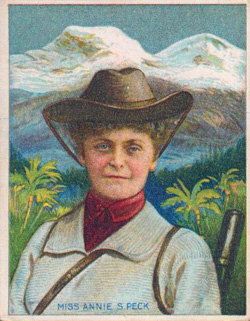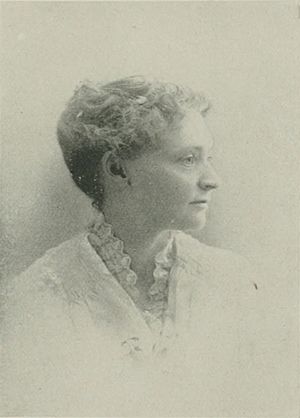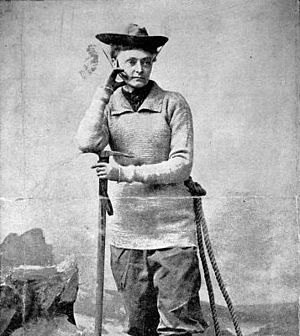Annie Smith Peck facts for kids
Quick facts for kids
Annie Peck
|
|
|---|---|

Annie Smith Peck, from a trading card issued in 1911
|
|
| Born | October 19, 1850 |
| Died | July 18, 1935 (aged 84) |
| Nationality | American |
| Alma mater | Rhode Island College University of Michigan |
| Occupation | Mountaineer, Educator, Writer |
| Known for | Adventurer, Suffragist, Feminist |
Annie Smith Peck (born October 19, 1850 – died July 18, 1935) was an amazing American mountaineer and adventurer. A mountain peak in Peru, called Huascarán, was even named Cumbre Aña Peck in her honor!
Annie was also a strong supporter of women's right to vote. She traveled and gave many talks around the world. She wrote four books to encourage others to explore and travel.
Contents
Early Life and Education
Annie Peck was born in Providence, Rhode Island, on October 19, 1850. She was the youngest of five children. Her brothers were very competitive, which helped Annie become determined too.
Annie went to school in Providence. She graduated from Rhode Island Normal School in 1872. This school trained teachers. Annie taught Latin for a short time. But she really wanted to go to Brown University, like her father and brothers. However, she was not allowed in because she was a girl.
Instead, Annie moved to Saginaw, Michigan, to live on her own. She taught languages and math at Saginaw High School. While teaching, she decided she wanted to earn a college degree. Her family thought it was "folly" for her to go to college at age twenty-seven.
Annie wrote to her father, explaining why she wanted the same education as her brothers. She said times were changing fast. She insisted she wanted to study for many years. Her father finally agreed to support her education. In 1874, Annie enrolled at the University of Michigan. This university had started accepting women in 1871.
Annie graduated with honors from the University of Michigan in 1878. She studied Greek and other classical languages. She earned a master's degree in Greek in 1881. After that, she taught at Purdue University. In 1884, Annie traveled to Europe. She continued her studies in Germany and Greece. In 1885, she became the first woman to attend the American School of Classical Studies at Athens. There, she studied archeology.
Career as an Adventurer
Annie Peck first worked as a teacher. But in the mid-1880s, she found a new passion: mountaineering. By 1892, she decided to make a living from her adventures. She became a public speaker, a mountaineer, and an author. As she climbed and explored in Latin America, she also promoted peace between the Americas. She shared her knowledge through her talks and books.
From Teacher to Speaker
Annie taught in several cities, including Providence and Saginaw. She was a professor at Purdue University from 1881 to 1883. After studying in Europe, she taught Latin at Smith College. By 1892, she stopped teaching. She earned money by giving talks and writing about her travels and climbs.
Record-Breaking Climber
Annie discovered her love for climbing in Europe in 1885. She climbed many mountains there and in the United States. In 1888, she climbed Mount Shasta in California, which is about 14,380 feet (4,383 meters) tall. She also climbed smaller mountains in Italy and Switzerland.
In 1895, Annie climbed the Matterhorn. This was a famous mountain in Europe. However, people talked more about her climbing clothes than her achievement! She wore a tunic, boots, and baggy trousers. This was unusual for women at the time. The New York Times even discussed what women should wear and what they could achieve.
Annie continued her climbs in Mexico. In 1897, she climbed Pico de Orizaba, which is 18,406 feet (5,610 meters) high. This was the highest climb ever made by a woman in the Americas at that time. She also helped start the American Alpine Club in 1902.
Even in her fifties, Annie wanted to set a new climbing record. In 1903, she went to South America. She was looking for a mountain taller than Aconcagua in Argentina. In 1908, with two Swiss guides, she was the first to climb the north peak of Huascarán in Peru. This peak is 22,205 feet (6,768 meters) high.
Another climber, Fanny Bullock Workman, challenged Annie's claim. Workman had climbed Pinnacle Peak in the Himalayas. It was the world record for the highest altitude climb. Engineers were hired to check Annie's altitude. They found that Annie had miscalculated the height of Huascarán. She was about 2,000 feet (600 meters) off. So, Annie held the record for the Americas, but Workman kept the world record.
In 1911, at age 61, Annie climbed Coropuna in Peru. It is 21,083 feet (6,426 meters) tall. When she reached the top, Annie placed a "Votes for Women" banner there. This showed her support for women's right to vote. She later wrote a book about her climbs called A Search for the Apex of America (1911). In this book, she famously said, "My home is where my trunk is."
Later Years and Legacy
In 1929–30, Annie took a seven-month trip around South America. She traveled mostly by airplane. She wanted to show how easy and safe commercial flights were. This was the longest air journey by a North American at the time. She wrote her last book, Flying Over South America (1932), about this trip. Annie kept climbing even when she was old. Her last mountain was Mount Madison in New Hampshire, which she climbed at age eighty-two.
Annie also wrote two other popular books about her travels: The South American Tour (1913) and Industrial and Commercial South America (1922). These books were helpful for diplomats, business people, and tourists. Besides being a founding member of the American Alpine Club, Annie was also president of the Joan of Arc Suffrage League. She became a fellow of the Royal Geographical Society and joined the Society of Woman Geographers.
Death and Honors
Annie Peck never married. In 1935, at age eighty-four, she started a world tour. But she became sick while climbing the Acropolis of Athens. She returned to her home in New York City and died of lung infection on July 18, 1935. Her ashes were buried in Providence, Rhode Island.
Annie is remembered for her adventurous spirit in mountaineering. Her personal papers, including diaries and photos, are kept at the Brooklyn College Library.
Honors and Awards
- In 1927, the Lima Geographical Society renamed the northern peak of Huascarán "Cumbre Aña Peck" to honor her as its first climber.
- In 1930, the Chilean government gave Annie the Decoration al Merito award.
- Peru's government gave her a gold medal. They recognized her work in exploring and gathering information about South American trade and industry. They also honored her for climbing the high peaks of the Peruvian Andes.
Selected Published Works
Annie Peck wrote many magazine articles and four books:
- The Search for the Apex of America: High Mountain Climbing in Peru and Bolivia, Including the Conquest of Huascaran, with Some Observations on the Country and People Below (1911)
- The South American Tour (1913)
- Industrial and Commercial South America (1922)
- Flying Over South America: Twenty Thousand Miles by Air (1932)



